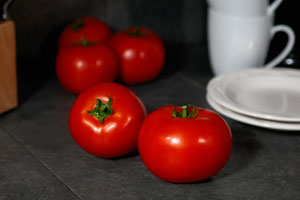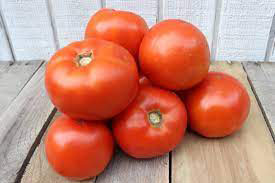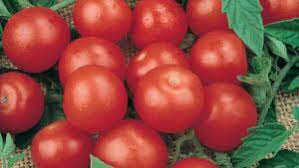|
Thunderbird - The 2023 San Antonio Rodeo Tomato
Thunderbird is an improved quality, high-yielding hot set determinate round hybrid variety with a strong plant and good general disease resistance such as:
DISEASE KEY
| CODE | DISEASE | PATHOGEN |
|---|
| HIGHLY RESISTANT |
|---|
| Aal | Alternaria stem canker | Alternaria alternata f. sp. lycopersici |
| Fol: 1-3 | Fusarium wilt | Fusarium oxysporum f. sp. lycopersici |
| For | Fusarium crown & root rot | Fusarium oxysporum f. sp. radicis-lycopersici |
| Vd | Verticillium wilt | Verticillium dahliae |
| TOLERANT |
|---|
| Sbl | Gray leaf spot | Stemphylium botryosum f. sp. lycopersici |
| Sl | Gray leaf spot | Stemphylium lycopersici |
| Ss | Gray leaf spot | Stemphylium solani |
| Aal | Alternaria stem canker | Alternaria alternata f. sp. lycopersici |
 TYLCV: (Israel strain) Tomato yellow leaf curl Tomato yellow leaf curl bigeminivirus (Israel strain)
TYLCV: (Israel strain) Tomato yellow leaf curl Tomato yellow leaf curl bigeminivirus (Israel strain)
The plants have a good balance of cover and ease of harvest. Fruit is extra-large in size, very firm, with good shelf-life. The color is deep red and part of the Sakata high color range. Thunderbird is a dual-purpose variety with both vine-ripe and mature green potential.
Characteristics
- Fruit is slightly flattened globe, uniform ripening, and ripens to a deep red color
- Demonstrates fruit quality uniformity with exceptional firmness
- High yields of large to extra-large fruit that hold up well; WEIGHT ~250-300g / 8-12 Oz. Thunderbird is in the same family as ‘Red Snapper’
(https://www.plantanswers.com/Articles/Rodeo-Tomato-for-2020--Red-Snapper.asp) but produces larger fruit
- Performs well in early and mid-season plantings.
DAYS TO MATURITY FROM TRANSPLANT 72-75
- Plant habit provides excellent foliage protection to the crop
A selection from Sakata® seed. https://sakatavegetables.com
Experimental # STM5187
Opinion about taste of tomatoes differs from person to person, so try several varieties to see which one tastes best to you when grown in your garden. However, this might be the best tasting tomato that you have ever planted.
 So, have you ever wondered how some gardeners always harvest the first tomatoes of the season?
So, have you ever wondered how some gardeners always harvest the first tomatoes of the season?
In most cases these “early bird” winners are “potting-up” their plants in one-gallon or larger containers prior to setting them out in the garden for spring, when the soil and air temperatures have warmed up enough to support tomato plant growth and fruit setting (early March through the first week or so of April).
To “pot up” your transplants, fill your gallon black plastic nursery container with a premium pre-moistened peat based potting mix and cut that with an additional 20% high grade finished compost. Enrich the blended mix with copious amounts of a slow-release fertilizer made especially for containers, such as Nelson Plant Food NutriStar’s Tomato/Vegetable Garden or COPIOUS AMOUNTS (4 times the label recommended amount!! i.e., YOU CANNOT BURN OR DAMAGE A PLANT BY USING TOO MUCH OF OSMOCOTE PLUS.
The key plant nutrient will be nitrogen. If adequate plant fertility is not maintained, the tomato bush will be small, yellow in color and produce much less fruit. Upgrade the transplants in the container. They can be planted deeply; tomatoes are one of the few plants that can tolerate deep planting. Adventitious roots will form along the whole stem. This is especially important if your transplants are leggy or top heavy. Start with healthy, dark green, well-established transplants. They should acclimatize to the wind and sun.
The goal of the “potting up” activity is to maintain the fast growth rate established at the nursery. Place the potted-up tomato in a full sun location out of the wind. The wind can injure foliage and reduce overall plant growth, so a small plant stake might be needed anchored to the main stem. A greenhouse is ideal, but many locations on the patio or the south side of the house also work well.
 It is important to keep the tomatoes adequately watered, BUT NOT OVER-WATERED. That is why we start out with a Premium peat based potting mix and compost mix. Watering frequency will depend on the water-holding capacity of the potting mix used and the plant size. Check the mix moisture by digging around in the pot—if you feel moisture—DO NOT WATER. Too much watering of young plants can cause roots to rot, and you will have to get replacement plants. Also, you should apply a dilute water-soluble fertilizer, such as 20-20-20 or Hasta-Gro, at least once a week when watering. The high-quality potting mixes are very well drained so they usually will not become soggy. Reduce watering when the weather is overcast and/or cool. If the plant is subjected to more than a few hours of sub 40° F temperature it will stop growing. You will recognize this when the plant stops growing and you see purplish coloring on the leaves. This condition often happens if you plant the tomatoes directly into the garden in early March and are not covered with a plant wind and temperature protection cover like N-Sulate until mid to late April.
It is important to keep the tomatoes adequately watered, BUT NOT OVER-WATERED. That is why we start out with a Premium peat based potting mix and compost mix. Watering frequency will depend on the water-holding capacity of the potting mix used and the plant size. Check the mix moisture by digging around in the pot—if you feel moisture—DO NOT WATER. Too much watering of young plants can cause roots to rot, and you will have to get replacement plants. Also, you should apply a dilute water-soluble fertilizer, such as 20-20-20 or Hasta-Gro, at least once a week when watering. The high-quality potting mixes are very well drained so they usually will not become soggy. Reduce watering when the weather is overcast and/or cool. If the plant is subjected to more than a few hours of sub 40° F temperature it will stop growing. You will recognize this when the plant stops growing and you see purplish coloring on the leaves. This condition often happens if you plant the tomatoes directly into the garden in early March and are not covered with a plant wind and temperature protection cover like N-Sulate until mid to late April.
To maintain the tomato transplant in a growing state, move it to shelter when temperatures below 40 degrees F. are forecasted. That may mean moving the containers into the house on cold evenings.
If you do everything as described above, your “potted up" plants will become quite large and may even begin blooming by late March or early April. The plants can then be transplanted to the vegetable garden or a much larger 20-inch plus diameter container. DO NOT let plants set fruit before moving to a permanent location. If fruit are allowed on transplants, the plants will be stunted when establishing them in the garden location. So, remove this early fruit for ample plant establishment! DO NOT apply organic mulch around tomato plants until early May, when soil temperatures have warmed. Then mulch two inches with an organic double shredded hardwood mulch that has some finished compost. If the plant is grown in a container, be sure to water and continue feeding every week with a water-soluble fertilizer as recommended on the label.
A tomato plant will produce much more fruit if caged. Cages should be at least 4-5 feet tall with a 16–20-inch diameter. Anchoring the cages will minimize the wind from turning over the cages. Drip irrigation is the best method to water. In six-to-eight weeks, you should potentially harvest up to 15 to 20 plus pounds of marketable tomatoes and you’ll be the talk of your neighborhood!
Good Luck and Happy Gardening this spring with your new tomatoes. Who knows, this might be the best tomato that you have ever grown and eaten. Remember, you don’t need to plant many, just do a good job with the few that you are growing.
|
|
|



